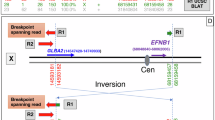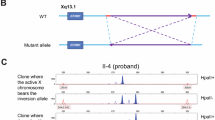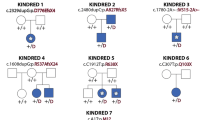Abstract
Craniofrontonasal syndrome (CFNS) is an X-linked developmental malformation, caused by mutations in the EFNB1 gene, which have only been described since 2004. A genotype–phenotype correlation seems not to be present. As it is of major importance to adequately counsel patients with EFNB1 mutations and their parents, and to improve diagnosis of new patients, more information about the phenotypic features is needed. This study included 23 patients (2 male, 21 female) with confirmed EFNB1 mutations. All patients underwent a thorough physical examination and photographs were taken. If available, radiological images were also consulted. Hypertelorism, longitudinal ridging and/or splitting of nails, a (mild) webbed neck and a clinodactyly of one or more toes were the only consistent features observed in all patients. Frequently observed phenotypic features were bifid tip of the nose (91%), columellar indentation (91%) and low implantation of breasts (90%). In comparison with anthropometric data of facial proportions, patients with CFNS had a significantly different face in multiple respects. An overview of all phenotypic features is shown. Patients with EFNB1 mutations have a clear phenotype. This study will facilitate genetic counseling of parents and patients, and contribute to the diagnostic and screening process of patients with suspected CFNS.
Similar content being viewed by others
Log in or create a free account to read this content
Gain free access to this article, as well as selected content from this journal and more on nature.com
or
References
Cohen MM Jr : Craniofrontonasal dysplasia. Birth Defects Orig Artic Ser 1979; 15: 85–89.
Reynolds JF, Haas RJ, Edgerton MT, Kelly TE : Craniofrontonasal dysplasia in a three-generation kindred. J Craniofac Genet Dev Biol 1982; 2: 233–238.
Grutzner E, Gorlin RJ : Craniofrontonasal dysplasia: phenotypic expression in females and males and genetic considerations. Oral Surg Oral Med Oral Pathol 1988; 65: 436–444.
Kere J, Ritvanen A, Marttinen E, Kaitila I : Craniofrontonasal dysostosis: variable expression in a three-generation family. Clin Genet 1990; 38: 441–446.
Suzuki H, Nara T, Minato S, Kamiishi H : Experience of surgical treatment for craniofrontonasal dysplasia. Tohoku J Exp Med 1991; 164: 251–257.
Kapusta L, Brunner HG, Hamel BC : Craniofrontonasal dysplasia. Eur J Pediatr 1992; 151: 837–841.
Natarajan U, Baraitser M, Nicolaides K, Gosden C : Craniofrontonasal dysplasia in two male sibs. Clin Dysmorphol 1993; 2: 360–364.
Saavedra D, Richieri-Costa A, Guion-Almeida ML, Cohen MM Jr : Craniofrontonasal syndrome: study of 41 patients. Am J Med Genet 1996; 61: 147–151.
Orr DJ, Slaney S, Ashworth GJ, Poole MD : Craniofrontonasal dysplasia. Br J Plast Surg 1997; 50: 153–161.
Wieacker P, Wieland I : Clinical and genetic aspects of craniofrontonasal syndrome: towards resolving a genetic paradox. Mol Genet Metab 2005; 86: 110–116.
Kawamoto HK, Heller JB, Heller MM et al: Craniofrontonasal dysplasia: a surgical treatment algorithm. Plast Reconstr Surg 2007; 120: 1943–1956.
Young ID : Craniofrontonasal dysplasia. J Med Genet 1987; 24: 193–196.
Moffat SM, Posnick JC, Pron GE, Armstrong DC : Frontonasal and craniofrontonasal dysplasia: preoperative quantitative description of the cranio-orbito-zygomatic region based on computed and conventional tomography. Cleft Palate Craniofac J 1994; 31: 97–105.
Mahore A, Shah A, Nadkarni T, Goel A : Craniofrontonasal dysplasia associated with Chiari malformation. J Neurosurg Pediatr 2010; 5: 375–379.
Hurst J, Baraitser M : Craniofrontonasal dysplasia. J Med Genet 1988; 25: 133–134.
Wieland I, Jakubiczka S, Muschke P et al: Mapping of a further locus for X-linked craniofrontonasal syndrome. Cytogenet Genome Res 2002; 99: 285–288.
Compagni A, Logan M, Klein R, Adams RH : Control of skeletal patterning by ephrinB1-EphB interactions. Dev Cell 2003; 5: 217–230.
Twigg SR, Kan R, Babbs C et al: Mutations of ephrin-B1 (EFNB1), a marker of tissue boundary formation, cause craniofrontonasal syndrome. Proc Natl Acad Sci USA 2004; 101: 8652–8657.
Wieland I, Jakubiczka S, Muschke P et al: Mutations of the ephrin-B1 gene cause craniofrontonasal syndrome. Am J Hum Genet 2004; 74: 1209–1215.
Shotelersuk V, Siriwan P, Ausavarat S : A novel mutation in EFNB1, probably with a dominant negative effect, underlying craniofrontonasal syndrome. Cleft Palate Craniofac J 2006; 43: 152–154.
Wieland I, Reardon W, Jakubiczka S et al: Twenty-six novel EFNB1 mutations in familial and sporadic craniofrontonasal syndrome (CFNS). Hum Mutat 2005; 26: 113–118.
Vasudevan PC, Twigg SR, Mulliken JB, Cook JA, Quarrell OW, Wilkie AO : Expanding the phenotype of craniofrontonasal syndrome: two unrelated boys with EFNB1 mutations and congenital diaphragmatic hernia. Eur J Hum Genet 2006; 14: 884–887.
Twigg SR, Matsumoto K, Kidd AM et al: The origin of EFNB1 mutations in craniofrontonasal syndrome: frequent somatic mosaicism and explanation of the paucity of carrier males. Am J Hum Genet 2006; 78: 999–1010.
Davy A, Bush JO, Soriano P : Inhibition of gap junction communication at ectopic Eph/ephrin boundaries underlies craniofrontonasal syndrome. PLoS Biol 2006; 4: e315.
Wallis D, Lacbawan F, Jain M et al: Additional EFNB1 mutations in craniofrontonasal syndrome. Am J Med Genet A 2008; 146A: 2008–2012.
Wieland I, Makarov R, Reardon W et al: Dissecting the molecular mechanisms in craniofrontonasal syndrome: differential mRNA expression of mutant EFNB1 and the cellular mosaic. Eur J Hum Genet 2008; 16: 184–191.
Hogue J, Shankar S, Perry H, Patel R, Vargervik K, Slavotinek A : A novel EFNB1 mutation (c.712delG) in a family with craniofrontonasal syndrome and diaphragmatic hernia. Am J Med Genet A 2010; 152A: 2574–2577.
Makarov R, Steiner B, Gucev Z, Tasic V, Wieacker P, Wieland I : The impact of CFNS-causing EFNB1 mutations on ephrin-B1 function. BMC Med Genet 2010; 11: 98.
Apostolopoulou D, Stratoudakis A, Hatzaki A et al: A novel de novo mutation within EFNB1 gene in a young girl with Craniofrontonasal syndrome. Cleft Palate Craniofac J 2011; 49: 109–113.
Zafeiriou DI, Pavlidou EL, Vargiami E : Diverse clinical and genetic aspects of craniofrontonasal syndrome. Pediatr Neurol 2011; 44: 83–87.
Klein R : Eph/ephrin signaling in morphogenesis, neural development and plasticity. Curr Opin Cell Biol 2004; 16: 580–589.
Kwee ML, Lindhout D : Frontonasal dysplasia, coronal craniosynostosis, pre- and postaxial polydactyly and split nails: a new autosomal dominant mutant with reduced penetrance and variable expression? Clin Genet 1983; 24: 200–205.
Twigg SR, Babbs C, van den Elzen ME et al: Cellular interference in craniofrontonasal syndrome: males mosaic for mutations in the X-linked EFNB1 gene are more severely affected than true hemizygotes. Hum Mol Genet 2013; 22: 1654–1662.
Farkas L, Munro I : Anthropometric Facial Proportions in Medicine 1 edn. Springfield, Illinois: Charles C Thomas, 1987.
Reardon W, Temple IK, Jones B, Baraitser M : Frontonasal dysplasia or craniofrontonasal dysplasia and the Poland anomaly? Clin Genet 1990; 38: 233–236.
Acknowledgements
We thank Professor Dr Han Brunner for analyzing the samples of multiple patients. This study was funded by the CZ Fonds and Stichting Achmea Gezondheidszorg (Dutch Health Insurance Companies) and by the Wellcome Trust (093329 to SRFT and AOMW).
Author information
Authors and Affiliations
Corresponding author
Ethics declarations
Competing interests
The authors declare no conflict of interest.
Rights and permissions
About this article
Cite this article
van den Elzen, M., Twigg, S., Goos, J. et al. Phenotypes of craniofrontonasal syndrome in patients with a pathogenic mutation in EFNB1. Eur J Hum Genet 22, 995–1001 (2014). https://doi.org/10.1038/ejhg.2013.273
Received:
Revised:
Accepted:
Published:
Issue date:
DOI: https://doi.org/10.1038/ejhg.2013.273
Keywords
This article is cited by
-
Fetal MRI of the supratentorial brain abnormalities: what we should know about ventriculomegaly?
Japanese Journal of Radiology (2023)
-
Clinical and molecular characterization of craniofrontonasal syndrome: new symptoms and novel pathogenic variants in the EFNB1 gene
Orphanet Journal of Rare Diseases (2021)
-
Large-scale open-source three-dimensional growth curves for clinical facial assessment and objective description of facial dysmorphism
Scientific Reports (2021)
-
The osteoprogenitor-specific loss of ephrinB1 results in an osteoporotic phenotype affecting the balance between bone formation and resorption
Scientific Reports (2018)
-
Mllt10 knockout mouse model reveals critical role of Af10-dependent H3K79 methylation in midfacial development
Scientific Reports (2017)



